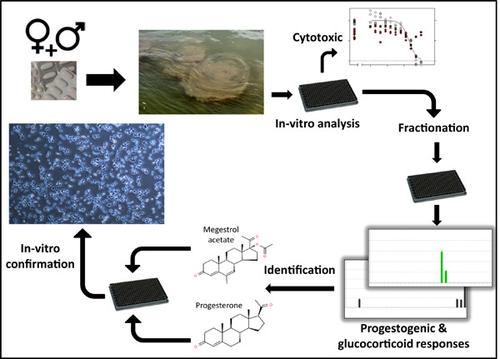当前位置:
X-MOL 学术
›
Environ. Toxicol. Chem.
›
论文详情
Our official English website, www.x-mol.net, welcomes your feedback! (Note: you will need to create a separate account there.)
Effect-Directed Analysis of Progestogens and Glucocorticoids at Trace Concentrations in River Water.
Environmental Toxicology and Chemistry ( IF 4.1 ) Pub Date : 2019-11-30 , DOI: 10.1002/etc.4609 Muhammad Arslan Kamal Hashmi 1, 2 , Martin Krauss 1 , Beate I Escher 1, 3 , Ivana Teodorovic 4 , Werner Brack 1, 2
Environmental Toxicology and Chemistry ( IF 4.1 ) Pub Date : 2019-11-30 , DOI: 10.1002/etc.4609 Muhammad Arslan Kamal Hashmi 1, 2 , Martin Krauss 1 , Beate I Escher 1, 3 , Ivana Teodorovic 4 , Werner Brack 1, 2
Affiliation

|
Effect-based monitoring is increasingly applied to detect and-in conjunction with chemical analysis-to identify endocrine-disrupting compounds (EDCs) in the environment. Although this approach of effect-directed analysis has been successfully demonstrated for estrogenicity and androgenicity, data on progestogens and glucocorticoids driving endocrine disruption are quite limited. We investigated progestogenic and glucocorticoid activities in Danube River water receiving untreated wastewater from Novi Sad, Serbia. After a 2-step fractionation, all fractions were tested with reporter gene bioassays for agonistic and antagonistic hormonal responses at progestogenic and glucocorticoid hormone receptors as well as with target and nontarget analytical screening of active fractions by liquid chromatography-high-resolution mass spectrometry. Due to masking by cytotoxic mixture components, the effects could not be detected in the raw water extract but were unraveled only after fractionation. Target chemical screening of the fraction that was active in the progesterone receptor (PR) assay revealed that progesterone and megestrol acetate were predominant drivers of PR-mediated activity along with medroxyprogesterone, dihydrotestosterone, androsterone, and epiandrosterone. Hydrocortisone was detected at sub-ng/L concentration in the active fraction in the glucocorticoid receptor (GR) assay but could not explain a significant fraction of the observed GR activity. The present study indicates that effect-based monitoring is a powerful tool to detect EDCs in the aquatic environment but that fractionation may be required to avoid masking effects of mixture components. Future effect-directed analysis studies are required to better understand the occurrence of EDCs and masking compounds in different lipophilicity windows, to finally reduce fractionation requirements for monitoring to a smart clean-up. Environ Toxicol Chem 2019;39:189-199. © 2019 The Authors. Environmental Toxicology and Chemistry published by Wiley Periodicals, Inc. on behalf of SETAC.
中文翻译:

河流水中痕量浓度的孕激素和糖皮质激素的效果导向分析。
基于效果的监视越来越多地用于检测和与化学分析结合使用,以识别环境中的内分泌干扰化合物(EDC)。尽管已经成功证明了这种针对效果的分析方法具有雌激素性和雄激素性,但有关孕激素和糖皮质激素驱动内分泌破坏的数据非常有限。我们调查了来自塞尔维亚诺维萨德的未经处理的废水在多瑙河水中的孕激素和糖皮质激素活性。经过两步分馏后,使用报告基因生物测定法测试所有馏分的孕激素和糖皮质激素受体的激动和拮抗激素反应,并通过液相色谱-高分辨率质谱法对活性馏分进行目标和非目标分析筛选。由于被细胞毒性混合物成分掩盖,在原水提取物中无法检测到这种作用,只有在分馏后才可以了解其作用。对孕激素受体(PR)测定中有活性的部分进行目标化学筛选,结果显示孕酮和乙酸孕甾酮是甲氧孕酮,二氢睾丸激素,雄甾烷和表雄甾烷与PR介导的活性的主要驱动力。在糖皮质激素受体(GR)分析的有效成分中,以低于ng / L的浓度检测到氢化可的松,但不能解释所观察到的GR活性的重要部分。本研究表明,基于效果的监测是检测水生环境中EDC的有力工具,但可能需要分级分离以避免掩盖混合物成分的影响。需要进行未来的效果导向分析研究,以更好地了解EDC和掩蔽化合物在不同亲脂性窗口中的出现,从而最终减少用于智能净化监控的分馏要求。Environ Toxicol Chem 2019; 39:189-199。©2019作者。Wiley Periodicals,Inc.代表SETAC出版的《环境毒理学和化学》。
更新日期:2019-12-27
中文翻译:

河流水中痕量浓度的孕激素和糖皮质激素的效果导向分析。
基于效果的监视越来越多地用于检测和与化学分析结合使用,以识别环境中的内分泌干扰化合物(EDC)。尽管已经成功证明了这种针对效果的分析方法具有雌激素性和雄激素性,但有关孕激素和糖皮质激素驱动内分泌破坏的数据非常有限。我们调查了来自塞尔维亚诺维萨德的未经处理的废水在多瑙河水中的孕激素和糖皮质激素活性。经过两步分馏后,使用报告基因生物测定法测试所有馏分的孕激素和糖皮质激素受体的激动和拮抗激素反应,并通过液相色谱-高分辨率质谱法对活性馏分进行目标和非目标分析筛选。由于被细胞毒性混合物成分掩盖,在原水提取物中无法检测到这种作用,只有在分馏后才可以了解其作用。对孕激素受体(PR)测定中有活性的部分进行目标化学筛选,结果显示孕酮和乙酸孕甾酮是甲氧孕酮,二氢睾丸激素,雄甾烷和表雄甾烷与PR介导的活性的主要驱动力。在糖皮质激素受体(GR)分析的有效成分中,以低于ng / L的浓度检测到氢化可的松,但不能解释所观察到的GR活性的重要部分。本研究表明,基于效果的监测是检测水生环境中EDC的有力工具,但可能需要分级分离以避免掩盖混合物成分的影响。需要进行未来的效果导向分析研究,以更好地了解EDC和掩蔽化合物在不同亲脂性窗口中的出现,从而最终减少用于智能净化监控的分馏要求。Environ Toxicol Chem 2019; 39:189-199。©2019作者。Wiley Periodicals,Inc.代表SETAC出版的《环境毒理学和化学》。



























 京公网安备 11010802027423号
京公网安备 11010802027423号